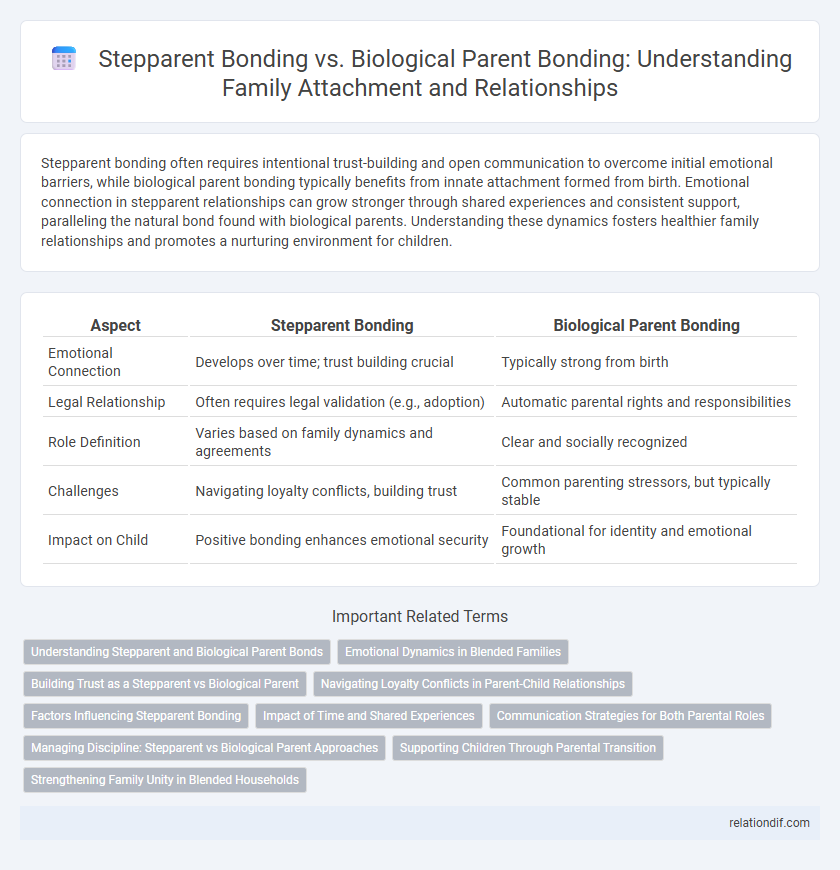Stepparent bonding often requires intentional trust-building and open communication to overcome initial emotional barriers, while biological parent bonding typically benefits from innate attachment formed from birth. Emotional connection in stepparent relationships can grow stronger through shared experiences and consistent support, paralleling the natural bond found with biological parents. Understanding these dynamics fosters healthier family relationships and promotes a nurturing environment for children.
Table of Comparison
| Aspect | Stepparent Bonding | Biological Parent Bonding |
|---|---|---|
| Emotional Connection | Develops over time; trust building crucial | Typically strong from birth |
| Legal Relationship | Often requires legal validation (e.g., adoption) | Automatic parental rights and responsibilities |
| Role Definition | Varies based on family dynamics and agreements | Clear and socially recognized |
| Challenges | Navigating loyalty conflicts, building trust | Common parenting stressors, but typically stable |
| Impact on Child | Positive bonding enhances emotional security | Foundational for identity and emotional growth |
Understanding Stepparent and Biological Parent Bonds
Stepparent bonding often requires intentional effort and time to build trust, as it lacks the biological connection that naturally influences a biological parent and child relationship. Understanding the unique dynamics of stepparent-child interactions, such as navigating role expectations and respecting boundaries, is crucial for developing a strong emotional bond. Research shows that positive communication, consistent support, and empathy significantly enhance the quality of stepparent and biological parent bonds within blended families.
Emotional Dynamics in Blended Families
Stepparent bonding in blended families often involves navigating complex emotional dynamics distinct from biological parent relationships, as trust and attachment develop over time rather than being innate. Emotional consistency, open communication, and patience play crucial roles in fostering secure connections between stepparents and stepchildren. Research indicates that positive emotional interactions within blended families contribute significantly to children's psychological well-being and overall family cohesion.
Building Trust as a Stepparent vs Biological Parent
Building trust as a stepparent requires consistent patience, open communication, and respect for the child's existing family bonds to gradually foster a secure emotional connection. Biological parents often benefit from innate attachment and shared history, which naturally support trust development over time. Stepparents must actively demonstrate reliability and empathy to overcome initial barriers and establish a foundation of mutual trust comparable to that of biological parents.
Navigating Loyalty Conflicts in Parent-Child Relationships
Navigating loyalty conflicts in parent-child relationships requires understanding the unique emotional challenges between stepparents and biological parents. Stepparent bonding often involves building trust while respecting existing bonds to avoid feelings of divided loyalty in children. Effective communication and mutual respect between all caregivers promote a stable and supportive family environment.
Factors Influencing Stepparent Bonding
Stepparent bonding is influenced by factors such as the child's age at the time of family blending, the stepparent's level of involvement in daily activities, and the quality of communication between all family members. Consistent emotional support and respect for existing family dynamics foster stronger attachment and trust in stepparent-child relationships. Research highlights that patience and gradual integration alongside open communication significantly enhance the development of positive stepparent bonds compared to immediate parental expectations.
Impact of Time and Shared Experiences
Stepparent bonding often requires more intentional shared experiences and consistent time investment to build trust and emotional connection, contrasting with biological parent bonding that benefits from early and innate attachment processes. Research shows that time spent together in meaningful activities directly correlates with stronger stepparent-child relationships and improved family cohesion. Quality shared experiences such as joint hobbies, daily routines, and open communication significantly enhance emotional bonds regardless of biological ties.
Communication Strategies for Both Parental Roles
Effective communication strategies for stepparents include active listening, expressing empathy, and maintaining consistent open dialogue to build trust and understanding with stepchildren. Biological parents benefit from reinforcing emotional security through affirmations and transparent conversations that affirm their ongoing presence and support. Both parental roles require patience and adaptability to navigate complex family dynamics and foster strong, resilient relationships.
Managing Discipline: Stepparent vs Biological Parent Approaches
Managing discipline in stepparent and biological parent relationships requires understanding distinct dynamics, as biological parents often have established authority and deeper emotional history, while stepparents must build trust and mutual respect gradually. Effective stepparent discipline balances firmness with empathy, avoiding overstepping boundaries, whereas biological parents might rely on consistent routines rooted in long-term parenting strategies. Research shows that collaborative communication and unified disciplinary approaches enhance family cohesion and improve child outcomes in blended households.
Supporting Children Through Parental Transition
Stepparent bonding and biological parent bonding both play crucial roles in supporting children through parental transitions, as children benefit from consistent emotional support and stability. Establishing trust and open communication within stepparent relationships helps alleviate feelings of confusion or loyalty conflicts often experienced during family restructuring. Research shows that positive stepparent involvement contributes to children's resilience and overall well-being, complementing the foundational attachment formed with biological parents.
Strengthening Family Unity in Blended Households
Stepparent bonding fosters trust and emotional connection, crucial for strengthening family unity in blended households where relationships evolve uniquely from biological parent bonds. Consistent communication and shared experiences cultivate mutual respect and a supportive environment, enhancing cohesion among all family members. Prioritizing empathy and patience helps navigate challenges, ultimately solidifying a unified family structure despite diverse familial roles.
Stepparent bonding vs Biological parent bonding Infographic

 relationdif.com
relationdif.com